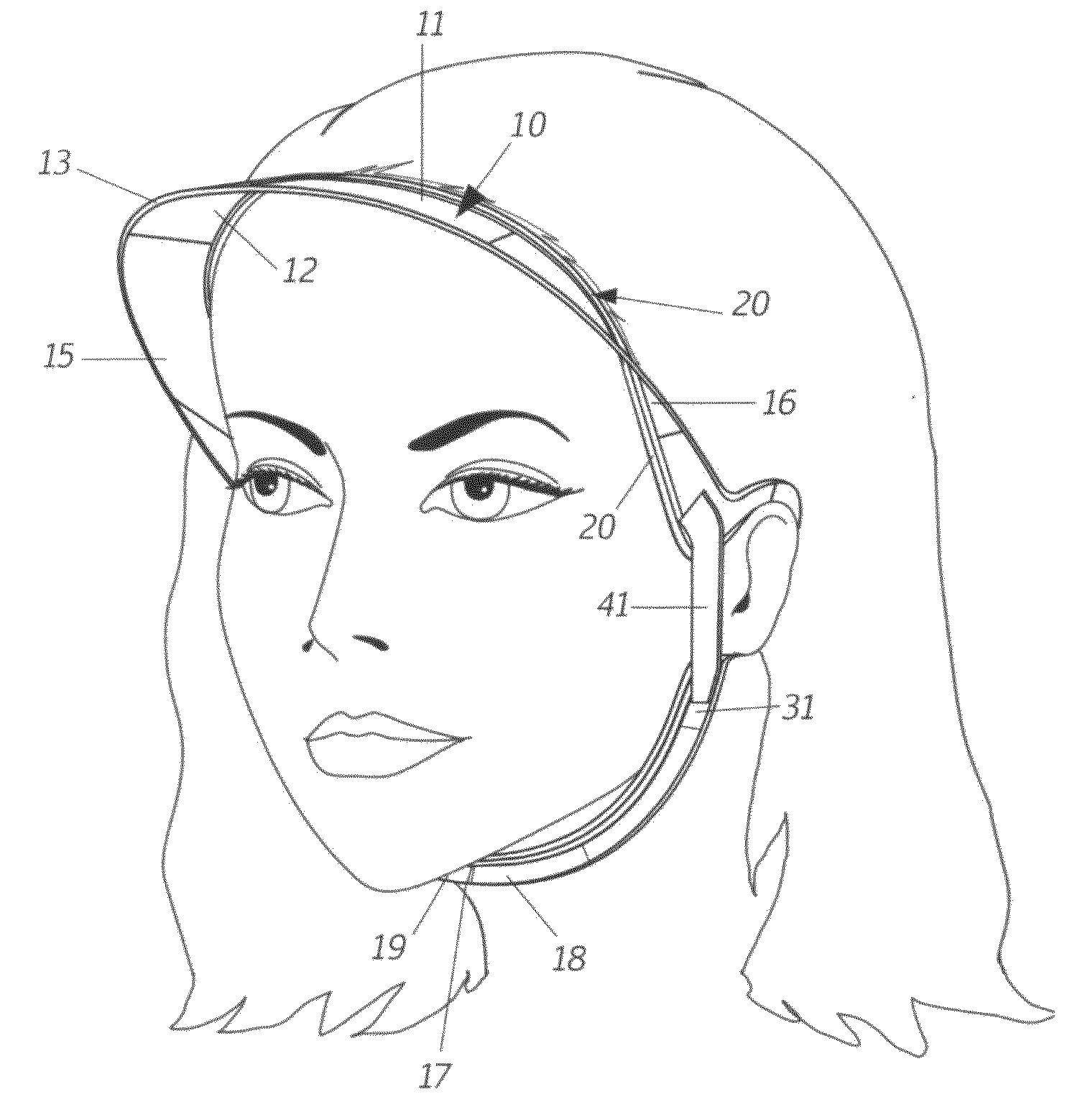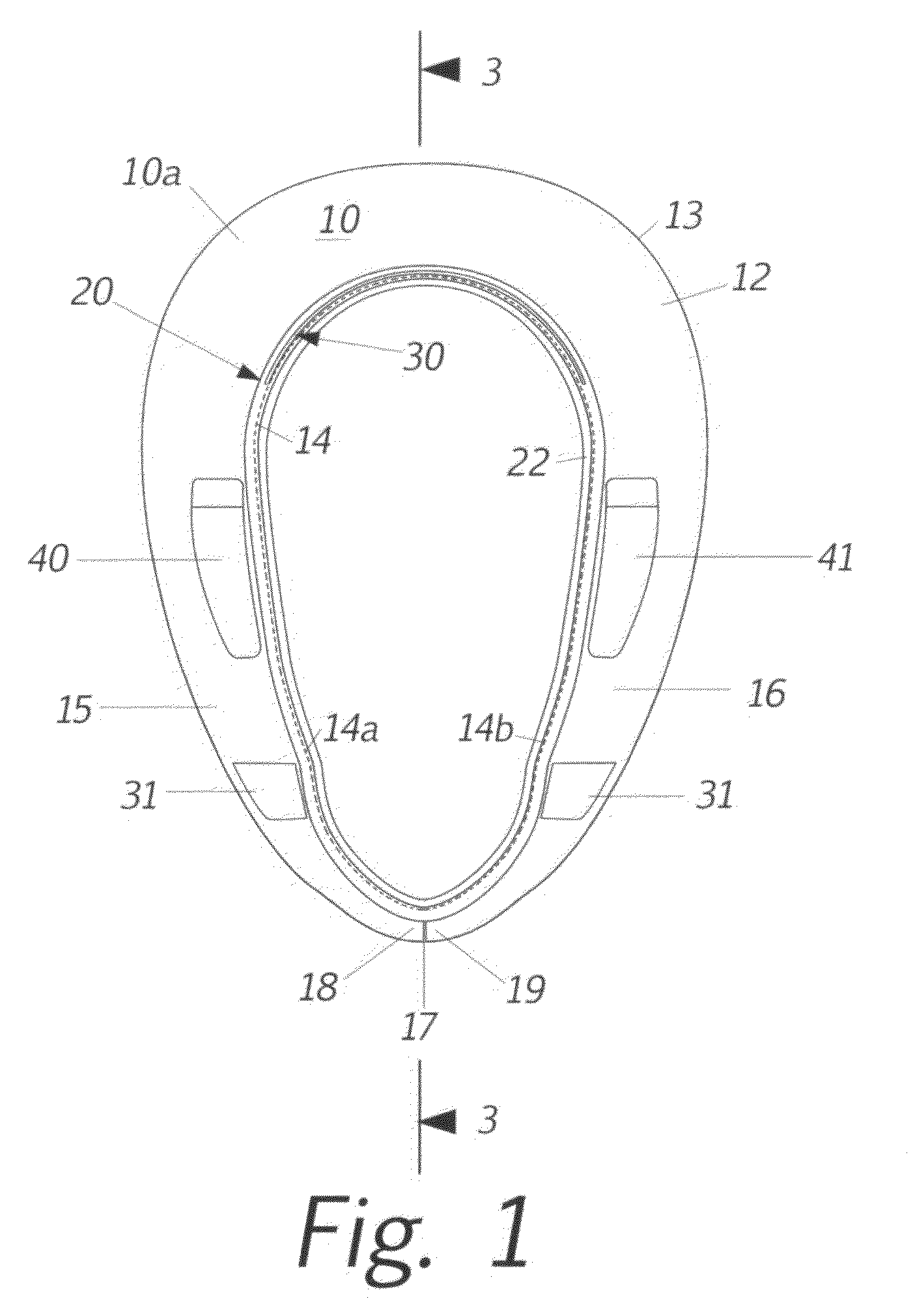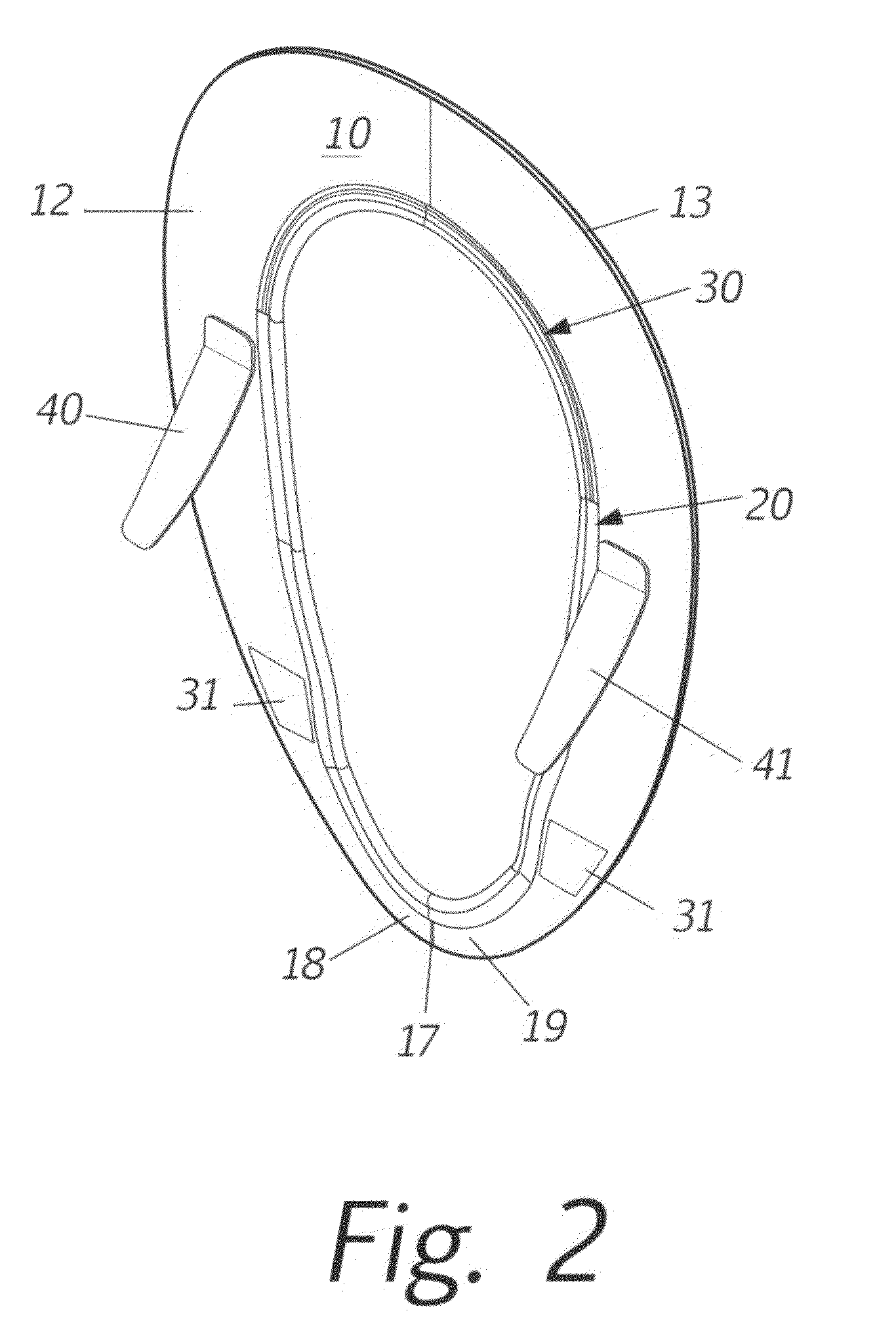Use of shampoos, conditioners and
hair treatment chemicals often results in residual runoff onto nearby tissues of the face.
In
hair washing situations such as those typically encountered under a
shower nozzle or when washing hair in the sink at home or at a beauty parlor with the head tilted back, water inevitably travels down the
forehead and cheeks, thus bringing shampoos, conditioners and water into the eyes.
This can be quite uncomfortable due to the irritating side effects of most
hair washing or treating chemicals.
A second inconvenience of the
hair washing and treating process is that runoff tends to remove makeup in the areas surrounding the hair line leaving a lighter
colored halo around the face.
This presents an impractical situation because makeup must then be reapplied to those areas.
When this happens in a public location it produces an embarrassing
halo effect on the customer.
Typically, when this occurs a
brush may be used to wipe away the clippings however this presents a problem when wearing makeup since the brushing process can smear carefully applied
mascara and foundation.
It is also known that the process of hair
drying can cause long and medium length hair to blow randomly upon the face sometimes resulting in hair tips flowing into the eyes of mouth.
If a person however is
drying their own hair this becomes quite impractical.
Lastly it is also noted that the hair
drying process which pushes hair onto the face is sometimes responsible for upsetting applied makeup, eye lash extensions and can cause hair to go into the eyes.
Reversely, the process of makeup application or
facial skin treatments, whether medical or esthetic, can be interrupted, contaminated, hindered in performance due to hair
contamination or interference of the bangs or hair around the temples.
It is also known that people who like to tan in the sun encounter the typical problem of acquiring an uneven tan on the face due to the multifaceted qualities of the face which favor tanning on some areas of the face while un-favoring others which are not in direct
sunlight.
However, although many of these devices serve their purpose with some degree of effectiveness, all of them suffer from a multitude of drawbacks originating from a functional, economic, esthetic, ease of application, ease of use, portability or versatility point of view.
Clearly, the difficulty and thus the opportunity, resides in providing a solution which grants all the above mentioned virtues in an economically feasible fashion and a sole design.
As I will disclose, a multitude of the prior art efforts are simply commercially impractical because some are difficult to apply, others are cost prohibitive and others yet are simply to cumbersome to use in a personal sense.
Furthermore, others appear unattractive and non disposable.
Allover, in fact, the prior art designs are incomplete solutions which is why they have had little commercial success.
A main drawback and
disadvantage, particularly concerning some of the prior art designs, limit the ability for personal use where ease of use concerning application, removal and continued mobility are desirable.
Such arrangements however are cumbersome and cannot be used either in the
shower or the sink.
Furthermore the devices are not disposable nor do they allow freedom to perform other tasks when worn.
This embodiment does not allow the user to move around because it is too cumbersome and it requires the front end to be tied to a vertical support.
However, this embodiment is very cumbersome and impractical as the view of the user is limited by a
small window in the
visor material.
This arrangement would not be efficient to be used in a sink or for applying
skin treatment to the face.
The straightness of the visor having no inclination in an upward or downward fashion makes it unsuitable for use with water because water would collect and drip from the edges underneath the visor and end up
wetting the face.
This arrangement which is very complicated and elaborate would prove to be difficult to put on and to manufacture.
Furthermore, this arrangement does not protect against water drainage.
This particular arrangement however binds the rear portion of the head and is not suitable for use with water because the inner rim contour is perfectly round and would not realistically and effectively create a good water seal with a head, leaving gaps which would allow water to flow down the face.
This arrangement, however, is exceedingly complex as it is equipped with weaving straps and carefully positioned components.
This model proves to be complicated for the user to put on.
Furthermore the steep angle of the visor portion in front of the eyes would not prove to be efficient in blocking water from the face but merely in protecting the eyes from random water splashes.
Young, U.S. Pat. No. 2,296,078, discloses a
face shield which is extremely complicated nature.
This model would be difficult to put on and wear.
This
system is very limiting for any work performed onto the hair and it is difficult to apply.
This arrangement, however, would not work in real practice because the
tail bend would create a bend along the rim seal and disrupt the water sealing abilities resulting in a leak.
This arrangement is not suitable for showers or sinks because the cape becomes an obstacle.
Furthermore the inner rim is perfectly round and would not offer a proper anatomical seal with the head of the wearer.
This arrangement is not suitable for use with water and is cumbersome to wear and put on.
Furthermore, this arrangement tends to bind hair behind the head limiting
hair care processes.
Such an arrangement however does not prove to be effective for use under water because of a number of perforations which
score the inner lining of the visor which would allow free passage of water.
Furthermore, this embodiment would prove to be inefficient in
contouring a specific hair line due to the absence of a means to deform the inner lining portion of the visor to conform with anatomical hairline contours of the user.
For this reason, although the design claims to be useful in the application of makeup and face creams, it excludes the ability to apply such treatments up to the hairline.
This embodiment is therefore insufficiently attractive from a functional standpoint.
Such an embodiment is not very stable because of the presence of an unsupported wide brim.
As a result, a minimal amount of water force or weight from above the rim would potentially flip the upward oriented brim in a downward manner thus suddenly getting the user wet.
Furthermore, this design would not be
usable in a wash basin with the head tilted backwards because the head portion of the user would rest upon the visor itself further destabilizing its structure.
A last drawback from this embodiment is the fact that the fashion in which the visor is worn inhibits a proper fitting around the hairline contour thus limiting its effectiveness in the
skin treatment applications.
Cancell, U.S. Pat. No. 2,600,392, discloses a shampooing device which is highly cumbersome and complex to use and
mount when self fitted.
Furthermore it is not of a feasible embodiment to manufacture.
Such an arrangement however would not work under a
shower or sink washing process since it lacks a visor portion to shed the water away from the face.
Furthermore, Mullen claims this embodiment to be self supporting, but systems which only attach to the ears without a
tertiary support somewhere else on the structure prove to be highly unstable and risk falling over and falling off the face.
Such an arrangement may apply for holding hair back during makeup application but it cannot lend itself for use under water due to the large gap opening between the free ends.
However, this embodiments does not possess a visor and thus is not useful under a shower or sink.
Furthermore it is not useful for blocking hairdrying heat or for collecting hair clippings.
However, if the foam becomes saturated, the liquid can drip over the bill and the headband, and potentially into the user's eyes and face.
Securing the Kuhlman visor snugly in place with a clip at the back of the head can be difficult without assistance.
Furthermore, the clip would seriously inhibit the hair washing process since hair is easily trapped and tangled with clips.
However, as with Kuhlman, such arrangements can be difficult to manipulate to a snug fit, requiring the user to manually fasten the device at the back of his or her head.
Furthermore these devices do not warrant a
soap safe experience under the shower or sink because the water collecting channel can overflow or buckle under the
water pressure.
In addition to these shortcomings, the devices lack simplicity and
cost effectiveness from a manufacturing standpoint which would warrant them commercial success such as a simpler version like the one I will propose, which can be made inexpensively in so far as to be affordably disposable in nature.
Another drawback from the devices above cited is the fact that the inner base portions of all of them are fairly wide, thus covering a major portion of the
forehead.
This particularity limits their flexibility and thus their efficiency in adapting to the many and varying anatomical hairline profiles which people have.
This means that the designs expressed above will not be equally efficient for all users.
Another drawback which plagues the above cited devices is their limited use.
Thus, although they would be able to protect the face from water,
soap and treatments applied to the hair, the opposite would not be possible.
However, the device would only be capable of diverting a very limited amount of dripping liquid to the rear portion the head before eventually overflowing or concentrating all the flow into the ears which remains unprotected.
Furthermore, the very narrow nature of the visor makes it inefficient to be used in a shower or sink under a powerful
water spray or inefficient to be used as a face protection from hair sprays and hair blowers.
Another apparent drawback of this device is that it would not be able to collect long strands of hair away from the face in order to allow face treatments because it is too narrow.
Also the rear strap does not appear to be very comfortable or economically feasible to make on a large scale.
Such an arrangement, however, binds the hair behind the head and limits workability of the hair in this area.
Although this method would prove workable, it is not feasible in a manufacturing sense.
Again, like other above mentioned examples of prior art, this embodiment binds the hair behind the head and is therefore less ideal.
This
system however is limited to hair drying purposes only, thus it lacks the ability to provide adequate water sealing abilities.
Furthermore the inner rim portion of this embodiment does not appear to possess a highly adaptable contour in order to follow the hairline accurately.
Such an arrangement however is very complex and not disposable in nature.
Furthermore this arrangement is not adaptable for skin
treatment use.
Such an arrangement becomes very rigid and difficult to contour around the hair line and covers a major portion of the
forehead thus it is useless for skin treatment applications.
Although the ear plugs prevent liquid from entering into the user's ears, they can be uncomfortable for the user.
Furthermore, the embodiment of this type of device constrains the hair behind the head thus eliminating some of the hair washing ability in this area.
The device proposed by Bowman is not commercially attractive because of its cost inhibitive manufacturing process and low esthetic appeal.
Such an arrangement does not provide protection against water and does not attach to the head in such a way to leave the rear portion of the head free from the
binding effect of the visor.
Although this unit appears to be adjustable by means of a lacing structure, the gap created by a wider
diameter head would leave an unprotected portion of the head vulnerable to water drippings.
Such an arrangement however covers most part of the face thus limiting the ability to use the visor as a means to apply
skin treatments.
Furthermore, this design also binds the hair behind the head limiting the work in this area as well.
However, these embodiments are not equipped with a visor portion and thus cannot be used under a shower or sink.
Furthermore, they cannot hold hair back or repair the face from hair dryer heat.
Such an arrangement does not readily accommodate differences in ear sizes and shapes, and it does not accommodate differences in relationship between ear size and hairline position.
In addition, the Zappala device is a relatively complex configuration.
Zappala's device cannot be inverted to use as a hair collector for skin treatment work either, nor can it be used for in sink hair washing because water would flow from the neck to the
chin to the mouth with your head upside down.
All of these factors result in a device that is relatively expensive to manufacture, and that is not readily adaptable for use by a variety of potential users in a variety of settings.
Certain other prior devices are simply too large, are not portable, or otherwise not suitable for comfortable personal use, but are more suitable for use in a commercial setting where the motion of the user's head will be restricted.
However, the Houston device is not self-supporting on the user's head; it must be either manually held to the head, or attached to a fixture where the head is presented to and held against the interior portion of the frame.
Seidman's device is not operable in a shower or sink setting as it would not protect the face properly.
Likewise, it cannot be used to hold hair back or protect the face from hair blowing.
These arrangements are not portable nor are they
usable for other tasks other than the immediate one for which they are intended.
It is however also evident that many of the previous attempts have not been able to identify and therefore encompass all necessary functions one would need from such a device into a single economical, simple and appealing design.
 Login to View More
Login to View More  Login to View More
Login to View More 


